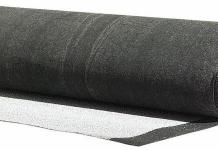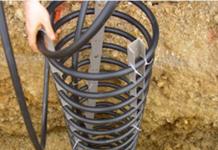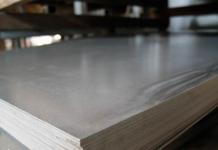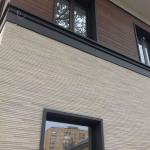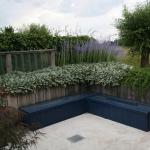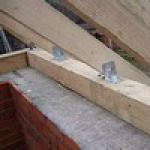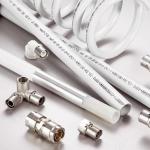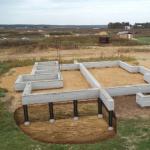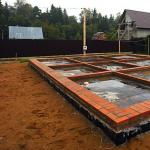On our site there is a pit measuring 6 x 6 m and a depth of 1 m. Apparently, the previous owners wanted to build something on this site, but they never got around to it. We do not plan construction, so we do not need a foundation pit. Is it possible to lay cut trees, shrubs in it, and then just fill it with soil? And what else can be done with this hole?
Natalya Egorova, Zelenograd
Rarely, who from summer residents gets a completely ideal land plot. For some it is too dry, for others it is too damp, for others it is too shady or windy. Well, the author of the letter was not lucky with a huge hole. But why not lucky? If you approach the matter thoughtfully and creatively, it is not so difficult to turn such a disadvantage into a virtue. Or even make a highlight out of it, which all the neighbors and guests of your dacha will look at.
Unfortunately, no details about the exact location, topography, soil and water conditions, features of development and the style of decorative design of the site are given in the letter. It is only known that it came from the city of Zelenograd, Moscow Region. Therefore, I will try to suggest only the most general options for action. I hope that they will be of interest to other gardeners as well.
Initial data
Zelenograd is located on the territory of the Klin-Dmitrov Ridge. This area is gently undulating, and the soils consist of glacial deposits under a relatively thin layer of red-brown and brownish loams.
In the Zelenograd area, soddy-podzolic soils are most common, on which spruce and spruce-small-leaved forests grow mainly. It is likely that the soil on the site does not pass water well, and it lingers for a long time in pits and pits. But another option is also possible - precipitation quickly goes to depth. Depending on the specific situation on the site, you need to make a decision on how to deal with the pit.
crop beds
The pit can be turned into a wonderful garden area. All experts agree that replacing nutrient-poor soil with more fertile soil is the ideal solution for obtaining high yields. And if there are not enough materials for this right away, this can be done in stages!
How to do?
Coarse plant remains are laid at the bottom of the pit: branches, branches, foliage. From above, they are partially covered with ordinary soil from your site. Then lay out a layer of nutritious organic matter - manure (possibly not rotted) or manure mixed with peat. After that, the surface is covered with a 20-30 cm layer of ready-made compost or good garden soil. Thus, the pit will turn into a large "warm bed", using which you can grow a wide variety of vegetable or berry crops.
Place to rest
If the site, on the contrary, is dry, well-drained and water never stagnates in the pit, you can arrange an excellent recreation area with a place for a fire or a barbecue. It may look like a separate garden, shallowly “recessed” compared to the level of the main plot.

Rest zone. Photo: Andrey Lysikov
How to do?
To prevent the earth from crumbling, retaining walls of brick or natural stone are built along the sides of the pit. For ease of access, stairs are constructed from one or two sides. The bottom of the pit is leveled, covered with a thick layer of rubble and sand, and then laid out with flagstone or clinker (specially baked brick, suitable for paving on the street). Both in the pit itself and around it, in accordance with the plan, they dig holes, fill them with a nutrient substrate and plant ornamental trees and shrubs, as well as perennial and annual flowers. Garden furniture is placed on the paved surface, a fire place is organized there or a brazier is installed. This cozy corner will surely become your favorite vacation spot!
mysterious pond
If the site is damp, with a high standing of groundwater, it is better not to fill the pit at all. On the contrary, in this case it is extremely valuable, since it can perform a draining function, collecting excess water and reducing the level of "primer". From this follows another option for using the pit - turning it into a garden pond.
How to do?
In order for the reservoir not only to collect water, but also to truly decorate your site, the foundation pit is given a beautiful shape by changing the contour of the coastline and depth. A pillow of gravel is poured at the bottom, if desired, large decorative stones are laid. The shores of the resulting pond are planted with spectacular near-water vegetation (air-shaped iris, marsh calla, loosestrife, moisture-loving cereals, etc.) or decorated with a mesh of coconut fiber. Large containers with aquatic plants, such as nymphs (water lilies), are placed at the bottom. For their successful wintering, a depth of 70-80 cm will be enough.

Lawn. Photo: Andrey Lysikov
green lawn
And the last. An unnecessary pit can simply be covered with imported soil and a lawn or a playground can be arranged in this place. But for this it is desirable to use only mineral substrates (sand, loam), and not plant residues. Organic materials (e.g. tree trunks, branches and stumps) buried in the excavation will gradually decompose and the surface of the soil in this area of the site will begin to sag, which will entail a lot of work on its subsequent leveling.
Is it possible to argue with the fact that the contemplation of the water surface makes a person feel tender, makes it possible to restore strength and peace of mind, and allows you to escape from problems for a while. Often not everyone has the opportunity to go out into nature, but it is quite possible to provide yourself and your family with a good rest if you build a pond in your summer cottage. The construction of even a small artificial reservoir will make the design of the site much more attractive. You should not be afraid that the construction of a complex hydraulic facility will be beyond your power - armed with some knowledge in the field of construction, it will be so difficult to do all the stages of design and construction work with your own hands.
How to choose a pond style
The first issue that needs to be resolved before starting construction is the choice of the style of the reservoir. The pond on the site should match the style of the country house and garden, support the concept of the landscape of the entire site. Depending on your preferences, the pond can be decorated:
in the Chinese style - with an intricate coastline, with an obligatory bridge and a stone lantern, an island of "dream" with a lonely growing tree or a beautiful stone located on it;
in Japanese - characterized by minimalism, surrounded by dwarf trees, having an extremely simple rectangular shape, decorated with a composition of stones;
in a landscape style - naturally fitting into the surrounding nature, surrounded by vegetation, perhaps - a composition of boulders and a path paved with flat stones;
in the style of a regular garden - with distinct geometric shapes, without being surrounded by lush vegetation;
in an avant-garde style - with clear, straight coastlines, without excessive vegetation, allowing proximity to unusually shaped structures made of glass, plastic or metal;
in a landscape style, the most picturesque, allowing you to design an arbitrary shape of a reservoir with stones and vegetation growing in a given area or exotic, with a bridge and paved paths around it;
in a formal style with a rectangular outline of the coast or a round one, emphasizing the beauty of the lines of a house located not far from it, with decking paths and a bridge made of the same material;
in the cascade version, the most complex in construction, but very picturesque, creating a special atmosphere of comfort in the garden with the soft murmur of water.
Building a pond with your own hands - how to choose a place for building a pond and determine its optimal size, materials
In order to minimize the problems that arise during operation and ensure its maximum lifespan, you will need to choose a location for the location of the reservoir, taking into account the recommendations of specialists.
choose a place for a reservoir
It should be borne in mind that green algae develop much more actively in a body of water illuminated throughout the day, which leads to "water bloom". Therefore, a shadow must necessarily fall on the territory chosen for placement, at least for several hours a day. It will also be wrong to place a reservoir in a shaded area of \u200b\u200bthe garden - ornamental plants planted near it will suffer from a lack of light.
A good option would be the location of the reservoir near the recreation area with a gazebo, barbecue or barbecue oven - vacationers will always have the opportunity to admire the amazing beauty of the water surface. It is desirable that the southwestern side of the reservoir be open to sunlight for about 5 hours. Large shady trees located near a pond will pollute the water with crumbling leaves and twigs.
reservoir dimensions
When constructing a pond with your own hands on the site, you should know that its optimal size can be about 3% of the total area. But if the plot is small, 6 acres, then even 18 square meters. m may be an unaffordable luxury.

At the same time, it is much easier to create a small reservoir on your own, it will take less physical effort, and the cost of materials will decrease. For this reason, the main criteria for deciding the size of the pond can be considered:
their financial capacity,
efficiency of the creators of the future reservoir,
the organic combination of the dimensions of the pond with other structures on the site,
compliance of the reservoir with the design style of the site.
The depth of the pond is designed depending on the functions that will be assigned to it, the pond should have a depth of three degrees:
- the first - for planting coastal plants
- the second - for shallow plants such as water lilies,
- third - ensuring safe wintering of fish.
You should not achieve a very large depth of the pond - it will be enough just to equip about a fifth of its area with a recess of about one and a half meters (this is somewhat lower than the freezing depth of the soil in winter), this is where the fish will winter.
what materials to use
There can be many options for using building materials, their choice mainly depends on the financial capabilities of the site owners. If we talk about a low-budget and prefabricated structure, then we can mention the option of using a ready-made plastic container, but if a capital structure is planned, then the best option would be to build a pond with a concrete base. It is the most costly in terms of money and time, in addition to digging a pit, you will need to build a formwork, reinforce it and pour it with concrete.

In practice, polyethylene film is often used for waterproofing a reservoir.
artificial pond on the site - construction plan
The construction of a pond on the site will require the use of special equipment, first of all, a pump for pumping and filtering water. If you plan to build a budget pond, then a rational option for waterproofing would be to use a moisture-resistant film. It is this method of constructing a reservoir that will be considered in this article.
Construction of a reservoir, its main stages
draw up a drawing of the object
First, we draw up a plan-scheme, on it we indicate the depth of the location of each of the curtains and their dimensions. You will also need to draw up an approximate scheme according to which the decoration of the reservoir will be carried out. The more carefully the design is carried out, the fewer errors and misunderstandings will occur in the process of work.

It will also require you to think about how to ennoble the pond on the site - at this stage we determine which of the components of the water composition can be emphasized - perhaps it will be some unusual plants, stone or sculpture.
do ground planning

When designing, do not forget to provide for a sufficient amount of space on the ledges-curtains for planting plants. You should also provide a place to accommodate each of the functional elements of the arrangement of the reservoir.
You can mark the outlines of the boundaries of the pond on the ground using ordinary sand, a rope or a long watering hose. Further along them, the contours are outlined with a solid line. Be sure to make sure that the banks of the reservoir are at the same level. For measurements, you can use either a water level of the desired length, or an ordinary half-meter level, superimposing it on a long board connecting opposite banks.
digging a pit
In accordance with the marked lines, they dig a foundation pit. Having dug a hole to the depth of the first tier, mark the boundaries of the curtains and only then continue to dig a recess to the next mark. Having reached the level of the second tier, they mark the area that will be occupied by the deepest part of the reservoir and dig a recess in the pit.

Considering that digging a large pond will require considerable physical effort and time, it may be a rational decision to attract professional diggers or rent a mini excavator.
If the site is located in low-lying or wetlands, then you should prepare for a situation where liquid begins to accumulate at the bottom of the pit. In this case, it will be necessary to use a special pump for pumping water with the inclusion of solid and suspended impurities. The pumped water can be drained into a trench dug nearby.
After digging the pit, by measuring, determine the area of its surface and find out the dimensions of the waterproofing film. Do not forget to add about half a meter of material along the edges of the film for allowances.
When digging a pit, a lot of excess soil is formed - it can be used with benefit. For example, to build the base of an alpine slide or a decorative slide to create a stream flowing into a pond.
When buying a film, you should purchase the same amount of geotextile - laying it under the film will prevent possible damage to polyethylene by plant roots. To save money, instead of geotextiles, you can use used linoleum or roofing material. Sometimes sand is poured into the pit and tamped down.
how to install film

The construction of ponds in the garden always requires waterproofing work, they should be approached with care. After laying a layer of geotextile (linoleum, sand), a film is carefully laid in the pit. A shallow trench is dug along the perimeter of the reservoir and excess film is placed in it so that it holds well, covered with rubble. It will be better to fit a heated film, therefore it is advisable to choose a hot summer day for work. The softened film will smoothly bend around each ledge in the pit.
The edge of the pond can be strengthened with beautifully laid natural stones, decorated with an unusually shaped boulder or a composition of several stone fragments.
Plants prepared in advance are placed in plastic containers and placed on tiers intended for them. The bottom of the pond is laid out with rubble or stones.

After completion of the preparatory work, you can fill the pond with water.
At the same time, it will not be superfluous to take meter readings and remember how much water is required - in the future this will help you choose the right pumping equipment for pumping water and the volumes of chemicals that are used to treat the liquid in the pond during operation.
Stream construction
The creation of a stream flowing into the reservoir will help rid the pond of the problem with stagnant water. the source of the stream should be above the water level in the reservoir, for example, on a hill built from excess soil. Water supply will be organized using a submersible pump. You should think carefully about masking all the components of the water supply system, the mouth of the stream can be decorated with beautiful stones, pebbles, handmade clay containers. A submersible pump is installed at the bottom of the reservoir, a pipe system is pulled from it to the source of the stream, while a pressure cleaning filter is necessarily installed in the system, it works more efficiently than a flow filter.

The pond is ready for use. Further, periodic care will be required for it: preventive water treatment, water purification from debris, control of algae reproduction. For the winter, plants grown in containers are removed from the water and taken to the basement.
Features of a fish pond

To ensure the normal maintenance of fish in the pond and to be able to fish, it will be necessary to determine the type of fish suitable for breeding in the cramped conditions of a small reservoir. Carp and carps are the most unpretentious to the conditions of keeping, in the conditions of an artificial reservoir, only 1 cubic meter of water is required to grow two dozen fish.
The optimal dimensions of a private reservoir are a depth of about 1.5 m with an area of 25 square meters. The advantage of such a reservoir is the rapid heating of water to 24-25 degrees - the temperature that is optimal for the life of fish of the carp family. At a temperature ten degrees lower, the appetite of the fish deteriorates, and there is a decrease in their growth activity. It is also dangerous to overheat the water to a temperature higher than 30 degrees.
If the owners have a desire to breed crayfish in the pond, then old ceramic containers or the remains of pipes will need to be laid on the bottom - crayfish will need such shelter for the molting period.
What water to use to fill the reservoir

Experts say that any water, including tap water, can be used to fill the pond. But after filling the pond, you should not immediately release fish into it - it is better to wait until the water warms up and microorganisms multiply in it, i.e. she will be alive. To speed up the process, you can add at least a few buckets of water from a settled reservoir to well or tap water, or simply throw clean cut grass on the bottom.
To improve the shores of the reservoir in which the fish will be bred, planting reeds and willows is used.
The microclimate in the reservoir must comply with the regulatory
Since living creatures will be settled in the pond, care will need to be taken to create the proper microclimate. The desired fish breeding environment should be neutral in acidity, in the order of pH 7-8. If the acidity is below normal, a calculated amount of soda solution or a portion of limestone is added to the water. Samples for acidity should be taken at different parts of the reservoir and at different depths. If the use of additives will give only temporary changes, then you will have to look for the cause that causes the change in acidity.

Before releasing fish into a pond, it will be necessary to balance the temperature in the fish transportation tank and in the pond - otherwise the fish may develop a temperature shock, in some cases it causes mass death of fish during the day.
What mistakes should be avoided when building a garden pond

We examined how to dig a pond on the site, recommendations will help to avoid the most common mistakes when performing work:
- You should not use stones of the same shape and size to decorate the reservoir - such a decision will reduce the decorative effect of the pond, give it a boring look.
- The pond should not be made very deep, justified depth, even in the case of fish breeding - within 2 m.
- You should not be afraid that the land for growing plants will pollute the water, in such soil there is a large percentage of clay, which prevents it from being washed away by water. In addition, actively developing plant roots will contribute to strengthening the soil. However, the container version of gardening has its advantages - it makes it possible to quickly regroup the plants and thereby transform the look of the reservoir. But the container method of keeping plants negatively affects their development and inhibits growth.
It is quite easy to equip drainage around your site to remove excess moisture. It is important to choose the optimal format according to which the drainage ditch will be prepared along the fence, and to determine the required set of materials and tools.
Problems to be solved:
- In areas with heavy rainfall, soil erosion is a problem;
- With a high passage of groundwater in the area, the soil is waterlogged;
- With a natural slope of the site, all the water accumulates in the lower part and “pulls” the entire fertile soil layer with it;
- In hilly and mountainous areas, depending on the season, a huge amount of water falls on the site from the territory above the slope;
- Atmospheric precipitation from the road surface accumulates under the fence along the perimeter of the site and can wash away the base and supports of the fence.
In all these situations, the optimal solution is the arrangement of drainage ditches or a productive hidden drainage system around the perimeter of the site.
The main task of the drainage ditch is to collect surface precipitation and remove it from the site.
However, it is not used to transport excess water., it is rather a localized drainage field, where excess water accumulates and gradually soaks into the ground, without bringing negative consequences to the buildings and the fertile soil layer of the site.
Kinds
There are three types of drainage:
- open;
- closed, laying of perforated pipes with backfill;
- backfill, the ditch is filled with coarse gravel and filter media for quick water drainage.
 To arrange drainage under the fence around the site from the outside, it is easiest to use open drainage ditches with reinforced slopes and a stable slope so that all excess water from the site and adjacent territories, including the road surface, quickly goes to the depth of groundwater or is transported to the drainage field, drainage well.
To arrange drainage under the fence around the site from the outside, it is easiest to use open drainage ditches with reinforced slopes and a stable slope so that all excess water from the site and adjacent territories, including the road surface, quickly goes to the depth of groundwater or is transported to the drainage field, drainage well.
Of the main advantages:
- small volume of land works;
- minimum materials;
- an extensive selection of slope strengthening;
- an easy way to maintain, clean and prevent drainage.
Requirements. Distance from the fence
For any drainage systems focused on the improvement of a private area, SP 104-34-96 and SNiP 2.05.07-85 are standardized. Optimal slopes for organizing a drainage ditch, distances to a fence and other structures, as well as options depending on the required throughput and characteristics of the drained area, such as general slope, soil type, etc., are discussed.
For a flat area or with a slight slope of up to five degrees to the horizon, the additional slope along the bottom of the ditch should be 3-5 ‰ (ppm), which corresponds to a difference in height of 3-5 cm for every 10 m.
In fact, the quality of the slope and its uniformity are determined on site during the preparation of the trench. It is difficult to ensure the shape of the trench with high accuracy, so it will be necessary to correct its geometry during the operation of the drainage.
 It is important that the drainage ditch be located at a distance from the fence posts and supporting structures so as not to erode their base. It is enough to move the upper boundary from the plane of the fence by 30-50 cm, and when arranging the strengthening of the walls, compact the soil so that the water does not wash out under the fence.
It is important that the drainage ditch be located at a distance from the fence posts and supporting structures so as not to erode their base. It is enough to move the upper boundary from the plane of the fence by 30-50 cm, and when arranging the strengthening of the walls, compact the soil so that the water does not wash out under the fence.
Wall reinforcement methods
The drainage ditch only partly acts as a transport system, the water entering it must be effectively absorbed into the soil along the entire length along the bottom of the ditch. It is not advisable to use concrete sections or otherwise reinforce the bottom.
It is allowed to use a rigid waterproof base only if underground communications pass under it, which should be protected from the effects of precipitation and groundwater.
Effective ways to strengthen slopes:

During the earthworks and the preparation of the foundation of the ditch, an extended pit is dug out with a width of about twice as much as necessary. A pillow of coarse sand or gravel is poured along the bottom.
The slopes are compacted manually or mechanically, covered with the material chosen for reinforcement. Next, a layer of soil is poured in the same way with tamping and compaction, only of a lesser intensity.
Calculation
In order for the drainage ditch to cope with the task, several important rules must be followed:
- The depth of the ditch along its entire length must be greater than the depth of the foundation nearby buildings by 300-500 mm;
- The slope along the entire length, taking into account turns or detours along the perimeter of the site, is directed to one point or along the lower boundary of the site;
- The slope is determined by the composition of the soil and the design capacity and is in the range of 1 to 5 cm for every 10 meters of extension.

If there is a drainage well that is separated from the contour of the drainage ditch, you should take the extreme point of the drainage system that is separated from the well and calculate the depth, and then calculate the control points located along the route that will be used to derive the correct geometry of the ditch.
DIY
Equipping a ditch is quite simple with your own hands, even if you do most of the land work by hand. However, the complexity will be caused by the presence of a large volume of selected soil along the length of the ditch.
It can be used to equip the front garden around the perimeter of the site so that it is raised above the general ground level.
 The easiest way to use the option is to strengthen the slopes with biomats, geomats, mesh or geotextiles. In this case, there is no need to over-compact the soil under the base, you can limit yourself to a small amount of loose drainage, sand or gravel, which will significantly reduce the load on the performer.
The easiest way to use the option is to strengthen the slopes with biomats, geomats, mesh or geotextiles. In this case, there is no need to over-compact the soil under the base, you can limit yourself to a small amount of loose drainage, sand or gravel, which will significantly reduce the load on the performer.
Price
A qualitatively, quickly and aesthetically pleasing drainage ditch can be organized using heavy rafter equipment.
In the minimum volume, an excavator is required, which will dig the base for the ditch in a matter of hours and at the same time it is easier to adjust the shape and geometry of the slopes, the depth of the base.
The executing company will prepare a project of work and an estimate in advance, so as not to guess about the cost of work after the fact and count on a guaranteed result.
The main burden on the budget of this event may be the preparation of a drainage well, if necessary, the rest of the work is much cheaper.
After the acquisition of building land, it often turns out that the terrain and geology of the area are not quite suitable for long-term use and agricultural activities. We will talk about raising and leveling the ground, from marking to protective landscaping.
When it makes sense to raise the site
One of the worst geomorphological conditions is considered to be the rise of the GWL above the depth of soil freezing. In such areas, heaving is especially pronounced, which is why there is a need for complex types of foundations, for example, pile-grillage. Shallow foundations do not work in such conditions, and full-fledged deepening requires support on a layer of soil 2.5-3 meters from the surface, above the foundation remains unstable and may be subject to precipitation due to high soil moisture.

This is not to say that geodetic site planning is a cheap method to get rid of soil problems. However, the usefulness of such a solution can be expressed economically in favor of the developer, if the raising of the soil eliminated problems with waterproofing, insulation and stabilization of the foundation and the resulting costs. This is usually true: planning allows you to solve the problem of poor geomorphology cheaper, and most importantly, faster, ultimately significantly reducing the shrinkage time of the foundation. This solution is especially shown in the construction of a log house or the installation of prefabricated foundations.

But raising the level on the site does not always solve the problem. With a large slope (more than 5-7%), terracing should be performed, and not raising the soil, and this is a completely different technology. On such slopes, even the involvement of special equipment for pouring bored piles costs less blood, and yet this one is one of the most difficult among the foundations. In the area, there may also simply not be a sufficiently dense layer of soil to support a building of the required mass on it. Raising the site in such an environment will not give anything at all; in any case, you will have to make the foundation floating.

Is drainage necessary?
Drainage systems are shown for artificially leveled areas with significant elevation changes, where, as we know, the problem cannot be solved by conventional raising. However, erosion and washout phenomena can be expressed even on small slopes, so minimal backfilling and surface drainage will have to be done.

On both boundaries of the site, located along the slope, it is necessary to dig rain trenches, one of which (lower) receives water from a transverse section arranged along the upper boundary of the site. The bottom of the trenches is covered with rubble, shrubs are planted along the slopes. Periodically, the trenches will have to be cleaned, usually the owner of the site has the one that is higher in level. In depth, the trenches should reach the upper aquiclude and cut it a little - about 20-30 cm. In order to less disturb the terrain, the depth of the trenches can be adjusted with hygroscopic material - the same rubble or construction battle.

If the direction of the slope and the trenches diverge by more than 15º, you should be prepared for increased water flow. The bottom of the upper trench should be paved with bricks, even better - with trays. In such areas, it makes sense to level the ground locally exclusively for buildings. In this case, the plot for the garden is simply protected from erosion by a trench across the slope, along the upper slope of which a willow tree or several birches are planted. It is recommended to fill the bottom of the trench and its upper slope with crushed stone to prevent silting.
There is no point in lining the entire layer of the embankment with black soil, just as there is no point in throwing clay over the fertile layer. The top layer will have to be removed to clean clay, and then returned to its place. If only part of the site is to be leveled, the excess soil is simply discarded onto the adjacent territory. If the site is planned completely, the work is carried out in two stages.

Excavation is carried out in order to eliminate the plastic washable layer between two dense layers, because the probability of the embankment sliding under its own weight is so high. The only exception is when the site is located simply in a lowland without a slope 20-30 cm below the adjacent territory. Here it is reasonable to limit ourselves to increasing the thickness of the fertile layer.

After the tight formation is exposed, a series of geodetic measurements is carried out. Knowing the configuration of the upper aquiclude, it is possible to determine the required volume of soil and start its delivery. At the same time, the volumes of crushed stone for backfilling are calculated and the drainage system is planned.
How to fill up the hill
To create an embankment, hard-plastic clay in a swollen state, loam or sandy loam is used. The ability of the backfill to pass water is determined by geomorphology: if, with an abundance of water, it is impossible to fill a tightly compacted terrace, or the backfill is carried out over a porous layer, the embankment should pass water to a limited extent. Optimally, if the bearing capacity of the clay corresponds to the underlying layer, so do not be too lazy to take samples.

In places where the site plan rises above the adjacent territories by more than 30-40 cm, it is necessary to carry out retaining filling with road gravel of a fraction of 70-90 cm. It is also used in surface drainage. Crushed stone is dumped immediately after excavation of the soil under the formed board. The width of the filling in the lower part must be at least half the height of the crushed stone shaft. On the sides of the site along the slope with crushed stone, you can immediately form the bottom of the drainage trenches.

Supports more than a meter high are covered with geotextile, which is immediately pressed down with a small layer of clay. After that, imported soil is started up and distributed over the site. The easiest laying route is starting from the shaft laid from the vehicle entry point to the opposite point, and then to the dump in both directions.
It is not recommended to pour more than 0.7-0.8 meters of clay embankment at a time. If necessary, raise more should wait for heavy rain or give the embankment time to overwinter. But with the use of tamping and excavating equipment, more impressive dumps can be quickly poured.
Is tamping or rolling necessary?
It is optimal if imported clay is consistently unloaded completely at the top level of the dump, and then collides with a bucket into unfilled areas. This is how high-quality compaction occurs, in which the final shrinkage takes place in one or two wetting.

Ramming is used when a high speed of work is required, for example, when the optimal time for embankment is limited seasonally or by weather. With alternate tamping, layers of pure clay can be poured 0.6-1.0 one after the other without prior wetting. We note once again that only swollen clay is suitable for tamping, dry clay will not take on water-resistant properties until swelling and subsequent compaction.
Layers of 30-40 cm can be compacted by rolling, but wheeled vehicles are poorly suited for these purposes. A caterpillar excavator is indispensable if the site is raised to a height of more than a meter, in other cases it is more reasonable to resort to manual transportation and leveling, and entrust the compaction to precipitation.

Note that it is often not necessary to manually level the site. Under the influence of the movement of surface water, a fresh embankment will eventually take on a natural slope. With an abundant flow of water, sometimes it is even necessary to slightly raise the embankment in advance in the lower part of the slope.
If you hurry and bring in black soil before the final compaction of the clay, erosion will quickly have its detrimental effect and the site will greatly lose its fertility. Unfortunately, only plowing the soil in spring and autumn saves from such a phenomenon, and even then only partially.

Chernozem or a fertile layer is better to be poured dry and not rolled, preferably manual distribution and leveling of the soil. The equipment must deliver black soil in the reverse order than the one in which the clay was poured. The area is filled from the edges to the center. At the end of the backfill, it is also filled.

This is the most time-consuming stage of raising the site: in addition to the fact that it is necessary to level the soil not only in one plane, but also with uniform compaction, the upper bulk layer may not be uniform. Usually, before unloading the chernozem, formwork is mounted, the foundation is cast and waterproofed, then sprinkled with rubble. Mounds of surface backwater are also arranged before the formation of a fertile layer.

Protection against erosion, strengthening the embankment on the slope
In addition to backfill and drainage, there are other ways to prevent soil erosion. Of these, the most famous and quite effective is planting plants with a developed root system along the upper and lower boundaries of the planned area, and actively absorbing water in the upper part.

Shrubs are planted along the slopes of drainage trenches to strengthen their walls. Plants from blackberries and rose hips to reeds are suitable here: they do not create much shade and at the same time pump water out of the soil well. From the upper tier, in addition to birch and willow, you can use undersized elderberry and sea buckthorn. On steep slopes, it is recommended to strengthen the embankment with geogrids and an underground drainage network.

But with a small difference in the level of the soil, dumping and protective landscaping will be quite enough.
The problem of flooding and increased waterlogging of the soil is familiar to the owners of sites located in the central region of Russia. Dampness and stagnant water after snow melt does not allow for proper preparation of the summer cottage for the summer season, and waterlogging of the soil with constant precipitation is detrimental to many plants. There are several ways to solve these problems, but the most effective is the arrangement of drainage.
When is a drainage system needed?
Drainage is a technology for collecting and diverting ground, melt and storm water from a site, technical and residential buildings. The drainage system prevents washing out, heaving and waterlogging of the soil, which occurs due to oversaturation with moisture.
The arrangement of the drainage system is not necessary in every area. In order to determine how badly your site needs drainage, you will need to conduct a visual inspection. Pay attention to whether the area is flooded after the snow melts, how quickly water is absorbed after watering the plants, whether there are puddles after heavy rain and heavy rain. If you have observed these signs more than once, then drainage is required.
Drainage system helps to remove stagnant water from the site
If there is little visual confirmation, then a simple experiment can be carried out - using a hand drill or a conventional shovel, you should dig a hole 70–100 cm deep. It is better to do this in several places on the site. If after 24–36 hours water accumulates at the bottom of the pit and does not leave, then this is direct evidence of oversaturation of the soil with moisture.
Soil drainage is carried out under the following conditions:
- high occurrence of groundwater;
- the site is located in an area with clay soil;
- the site is located in a lowland or vice versa - on a slope;
- The location of the site receives a large amount of precipitation.
The presence of drainage contributes to the preservation of finishing and facing materials used for laying garden paths, finishing the basement and facade of the building.
Types of dehumidification systems
There are a wide variety of land drainage systems. At the same time, in various sources, their classification can be very different from each other. In the case of drainage systems for suburban and summer cottages, it is recommended to use the simplest and most proven solutions.
Surface type drainage
Surface drainage is the simplest and most effective system. The main task is to drain the soil by draining water formed as a result of heavy rainfall and uneven snowmelt.
Grids protect the open drainage system from large debris
A surface drainage system is constructed over the area of the site, around the house and adjacent buildings, near garage structures, warehouses and the courtyard. Surface drainage is divided into two subspecies:
- Point - in some sources it is designated as local drainage. It is used to collect and divert water from a certain place on the site. The main area of application is drainage of areas under drains, near entrance doors and gates, in the area of containers and irrigation taps. Often used as an emergency system if another type of drainage is overloaded.
- Linear - used to drain the entire area. It is a system consisting of receiving trays and channels arranged at a certain angle, providing a constant flow of water. The drainage system is equipped with filter grates and sand traps. Trays and drains are made of PVC, polypropylene, HDPE or polymer concrete.
When installing a surface drainage system, it is recommended to combine point and linear drainage. This will ensure the most efficient operation of the system. If necessary, point and line drainage can be combined with the system described below.
deep drainage
Deep drainage is carried out in the form of a pipeline laid in places where it is necessary to constantly drain the soil or lower the groundwater level. Drains are laid with observance of a slope in the direction of the flow of water, which enters the collector, well or reservoir located outside the site.
The process of constructing deep drainage in a suburban area
To lower the groundwater level, pipes are laid along the perimeter of the site to a depth of 80-150 cm. In the case when it is necessary to divert water from the foundation of the building, the pipes must be laid below its depth. And also drainage pipes can be laid over the entire area of the site with a certain step. The distance between drains depends on the depth of their laying and the mechanical composition of the soil.
For example, when constructing a drainage system, when drains are laid to a depth of 0.9–1 m, the recommended distance between them is at least 9–11 m. On loamy soil under the same conditions, the step between drains decreases to 7–9 m, and on clayey up to 4–5.5 m. More detailed data for different depths of laying can be seen in the table below. The information is taken from the book "Draining land for gardens" by A.M.Dumblyauskas.
| Drainage depth, m | Distance between drains, m | ||
| sandy soil | loamy soil | Clay soil | |
| 0,45 | 4,5–5,5 | 4–5 | 2–3 |
| 0,6 | 6,5–7,5 | 5–6,5 | 3–4 |
| 0,9 | 9–11 | 7–9 | 4–5,5 |
| 1,2 | 12–15 | 10–12 | 4,5–7 |
| 1,5 | 15,5–18 | 12–15 | 6,5–9 |
| 1,8 | 18–22 | 15–18 | 7–11 |
When laying the pipe, the features of the terrain are observed. According to the technology, drains are laid from the highest to the lowest point on the site. If the site is relatively flat, then to give a slope, a slope is formed along the bottom of the trench. The minimum slope level is 2 cm per 1 linear meter of the drainage pipe when constructing drainage in clay and loamy soil. For sandy soil, a slope of 3 cm per 1 meter is observed.
When arranging drainage of a long length, a minimum slope must be observed along the entire length of the drainage route. For example, for a drainage system with a length of 15 m, the minimum level difference between the start and end points of the route will be at least 30 cm.
If possible, it is recommended to exceed the declared slope standards. This will provide faster drainage, reduce the risk of silting and clogging of the drain. In addition, digging a trench with a large slope is much easier than measuring out 1–2 cm.
Drainage at their summer cottage - the easiest way with instructions
In order to independently carry out the drainage of a land plot through a drainage system, you will need to familiarize yourself with the technology of work, calculate and purchase the necessary materials, prepare a tool and a place to perform work.
Surface drainage of a summer cottage
Open surface drainage is a universal solution for draining suburban areas of a small area. For example, for typical plots of 6 acres. You can use the diagram below as a basis. It depicts a drainage route in the shape of a Christmas tree. The distance between the drains, as discussed above, is selected based on the type of soil (see table).
An example of the location of the drainage system at their summer cottage
To carry out the work, you will need a shovel and a bayonet shovel, a tape measure, a bubble level, a hammer and a sharp construction knife. As materials, it will be necessary to prepare gravel of a fraction of 20–40, geotextiles, an edged bar or a board 2–3 m long.
For the construction of surface drainage in a summer cottage, you will need to do the following:

Sometimes, the base of the trench is concreted along the entire length of the drainage route. This allows you not to worry that over time the earthen walls will begin to crumble, the water flow will deteriorate, etc. But this approach is more laborious and requires the ability to work with concrete mix.
Drainage of the site using deep drainage
Deep drainage is a standard solution for draining summer cottages and suburban areas. A deep drainage system can be installed even when there is a protective pavement around the building, concrete or slab paths. If necessary, their partial dismantling can be performed, but in general the structure will not suffer.
An example of a project for a drainage system in a suburban area
Deep drainage works include the following:
- According to the design plan of the site, it is necessary to draw up a diagram of the location of the drainage pipes and determine the point of discharge of water, that is, the place from which the collected water will drain into the sewer pipes leading to the drainage well. The depth of the pipeline should be below the freezing level of the soil. For the Northwestern region, this value is about 60–80 cm.
Preparation of trenches for the construction of deep drainage
- Taking into account the plan, a trench is excavated along the perimeter and area of a site up to 1 m deep. The width of the trench is at least 30 cm. All horizontal sections of the trenches are combined into a single system, which is brought to the point of water discharge. After that, the trenches are dug with a slope of 2–4 cm per 1 m of surface. To check the quality of the runoff, the trenches are shed with a large volume of water. If necessary, the slope towards the drainage well increases.
A pit for a drainage well must be dug at the lowest point on the site
- At the lowest point of the site, a place is arranged for the installation of a water intake or filtering drainage well. For large areas located on loamy and clay soil types, it is better to install storage types of wells with a volume of up to 1000 liters. For small areas, both storage and filter wells can be used. The type of tank is selected based on the type of soil.
A wide sheet of geotextile is laid on top of the gravel layer.
- Fine-grained gravel is poured into the bottom of the trench. The thickness of the layer is 10 cm. Geofabric is laid on the gravel with an overlap on the walls of the trench. To fix the canvas to the walls, wooden or plastic pegs are used, which are driven into the ground. After that, a 10 cm layer of crushed stone with a fraction of 50–60 is poured onto the laid geotextile and carefully leveled in compliance with the slope. A drainage pipe from Ø 110 mm is laid on the crushed stone.
- In places where the drain turns, modular manholes are installed. The diameter and height of the well depend on the estimated volume of wastewater. To connect the pipe to the mounting hole, a coupling is used, which is coated with a waterproof sealant before joining. Similar actions are carried out to connect the drainage pipe to the well pipe.
An inspection drainage well is installed in places where the drainage pipe turns
- Before backfilling, the drainage system is checked for operability. To do this, a large amount of water is drained through the drains. If the water quickly drains and enters the well, then everything is done correctly and you can proceed to the final stage. In other cases, you need to find and fix the problem.
- A 20–30 cm layer of gravel with a fraction of 20–40 is poured over the drainage pipes and carefully leveled. After that, drains with laid rubble are covered with geotextiles. A 10-15 cm layer of quarry sand is poured over the geotextile and carefully compacted. The remaining space in the trench can be covered with fertile soil or ordinary soil from the site.
Ways to drain a site without drainage
Excessive moisture in the soil and stagnant water in the area are not always associated with a high level of groundwater. Sometimes this is due to abnormally low temperatures and heavy rainfall. The combination of these factors leads to the fact that moisture does not have time to evaporate, puddles and mold form on the soil surface.
Sanding clay soil is one way to drain a site without drainage.
If, due to some circumstances, the installation of a drainage system is impossible, then there are several effective ways to drain the land:

Of the above methods of draining the site, the most effective are the addition of a sufficient amount of fertile soil and the arrangement of trenches around the perimeter. On average, 1 m 3 of soil will cost 550–600 rubles. For a plot of 6 acres, 10–12 m 3 of soil is enough.
The easiest way to drain the soil on the site
The arrangement of shallow trenches filled with rubble is the easiest way to drain a summer cottage. Despite the general simplicity, this method is very effective and is able to cope with a large amount of water formed during the melting of snow.
Work on the arrangement of trenches around the perimeter and area of the site includes the following:

If desired, the second layer of crushed stone can be reduced, and the remaining space can be sprinkled with soil from the site. This will hide the drainage under the turf layer. It is not recommended to plant flowers and greenery over the drainage trench. This is fraught with their death due to the high humidity in this place.
How to clear a blockage in a drain pipe
Failure to comply with the technology of laying drainage pipes is the main cause of stagnation and poor drainage of water from distribution wells. In addition, very often stagnant water is not associated with blockage at all. Insufficient slope does not provide a constant and uniform discharge of accumulated water towards the drainage pit.
To clear small blockages, use a steel cable or a hose with strong water pressure.
The easiest way to clean drain pipes is to use a steel cable to clean the drains. At one end of the cable there is a spiral nozzle, at the other - a handle with which you can rotate the cable, creating a mechanical load at the site of blockage.
For cleaning pipes Ø110 mm and more, it is recommended to use a cable with a steel brush of the appropriate size. During the cleaning process, it is necessary to lower the cable into the drain pipe until its end reaches the blockage. Further, by rotating the cable clockwise, you need to try to break through the blockage or move it towards the water drain. Usually, small accumulations of silt and foliage are pushed through without much difficulty.
If it was not possible to eliminate the blockage, then it will be necessary to call specialists who, using a pneumatic installation and other equipment, will not only clear the blockage, but also carry out preventive cleaning of the entire surface of the drainage pipes.
Video: do-it-yourself site drainage
Oversaturation of the soil with moisture and stagnant water on the site are a big problem that affects not only the growth of fruit-bearing crops, but also reduces the life of a residential building. But it is worth remembering that an excess of water can be dealt with with the help of a drainage system. It is much worse if there is enough fresh water and moisture, and the arrangement of the well is impossible due to some circumstances.
